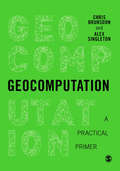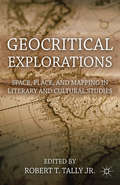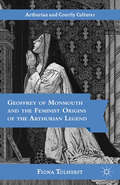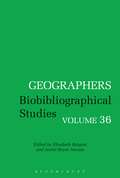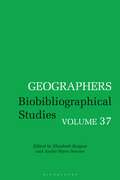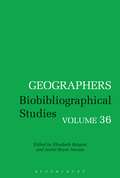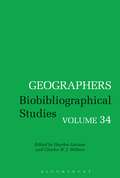- Table View
- List View
Geochemical Biomarkers
by T.F. Yen J.M. MoldowanFirst Published in 1988. Routledge is an imprint of Taylor & Francis, an informa company.
Geochemical Evidence for Long-Distance Exchange (Scientific Archaeology for the Third Millennium)
by Michael D. GlascockStudies of prehistoric exchange of goods provide information about the types of economic interaction, social organization, or political structures in which prehistoric peoples were engaged. Long-distance exchange is a special situation where the materials exchanged crossed significant boundaries, whether they were geographic, social, political, or otherwise. By examining the types and quantities of goods exchanged, along with the directions and distances they moved, archaeologists are able to examine the dynamic properties of exchange systems, i.e., how they operate and why they undergo change.The purpose of this volume is to present a number of case studies of long-distance exchange from around the world which demonstrate the use of geochemical analysis of artifacts to find evidence of exchange. More important than the use of analytical technique employed or the types of artifacts studied are the interpretations themselves which illustrate that exchange studies are maturing and helping archaeologists to develop more accurate models of exchange.
Geocomputation: A Practical Primer (PDF)
by Alex David Singleton Chris BrunsdonGeocomputation is the use of software and computing power to solve complex spatial problems. It is gaining increasing importance in the era of the ‘big data’ revolution, of ‘smart cities’, of crowdsourced data, and of associated applications for viewing and managing data geographically - like Google Maps. This student focused book: Provides a selection of practical examples of geocomputational techniques and ‘hot topics’ written by world leading practitioners. Integrates supporting materials in each chapter, such as code and data, enabling readers to work through the examples themselves. Chapters provide highly applied and practical discussions of: Visualisation and exploratory spatial data analysis Space time modelling Spatial algorithms Spatial regression and statistics Enabling interactions through the use of neogeography All chapters are uniform in design and each includes an introduction, case studies, conclusions - drawing together the generalities of the introduction and specific findings from the case study application – and guidance for further reading. This accessible text has been specifically designed for those readers who are new to Geocomputation as an area of research, showing how complex real-world problems can be solved through the integration of technology, data, and geocomputational methods. This is the applied primer for Geocomputation in the social sciences.
Geocomputation: A Practical Primer (Spatial Analytics and GIS)
by Alex David Singleton Chris BrunsdonGeocomputation is the use of software and computing power to solve complex spatial problems. It is gaining increasing importance in the era of the ‘big data’ revolution, of ‘smart cities’, of crowdsourced data, and of associated applications for viewing and managing data geographically - like Google Maps. This student focused book: Provides a selection of practical examples of geocomputational techniques and ‘hot topics’ written by world leading practitioners. Integrates supporting materials in each chapter, such as code and data, enabling readers to work through the examples themselves. Chapters provide highly applied and practical discussions of: Visualisation and exploratory spatial data analysis Space time modelling Spatial algorithms Spatial regression and statistics Enabling interactions through the use of neogeography All chapters are uniform in design and each includes an introduction, case studies, conclusions - drawing together the generalities of the introduction and specific findings from the case study application – and guidance for further reading. This accessible text has been specifically designed for those readers who are new to Geocomputation as an area of research, showing how complex real-world problems can be solved through the integration of technology, data, and geocomputational methods. This is the applied primer for Geocomputation in the social sciences.
Geocritical Explorations: Space, Place, and Mapping in Literary and Cultural Studies
by Robert T. Tally Jr.In recent years the spatial turn in literary and cultural studies has opened up new ways of looking at the interactions among writers, readers, texts, and places. Geocriticism offers a timely new approach, and this book presents an array of concrete examples or readings, which also reveal the broad range of geocritical practices.
Geocriticism: Real and Fictional Spaces
by B. WestphalGeocriticism provides a theoretical foundation and a critical exploration of geocriticism, an interdisciplinary approach to understanding literature in relation to space and place. Drawing on diverse thinkers, Westphal argues that a geocritical approach enables novel ways of seeing literary texts and of conducting literary studies.
Geodesign by Integrating Design and Geospatial Sciences (GeoJournal Library #111)
by Danbi J. Lee Eduardo Dias Henk J. ScholtenIn Europe, the emerging discipline of geodesign was earmarked by the first Geodesign Summit held in 2013 at the GeoFort, the Netherlands. Here researchers and practitioners from 28 different countries gathered to exchange ideas on how to merge the spatial sciences and design worlds. This book brings together experiences from this international group of spatial planners, architects, landscape designers, archaeologists, and geospatial scientists to explore the notion of ‘Geodesign thinking’, whereby spatial technologies (such as integrated 3D modelling, network analysis, visualization tools, and information dashboards) are used to answer ‘what if’ questions to design alternatives on aspects like urban visibility, flood risks, sustainability, economic development, heritage appreciation and public engagement. The book offers a single source of geodesign theory from a European perspective by first introducing the geodesign framework, then exploring various case studies on solving complex, dynamic, and multi-stakeholder design challenges. This book will appeal to practitioners and researchers alike who are eager to bring design analysis, intelligent planning, and consensus building to a whole new level.
Geoecology: An Evolutionary Approach
by Richard HuggettAnimals, plants and soils interact with one another, with the terrestrial spheres, and with the rest of the Cosmos. On land, this rich interaction creates landscape systems or geoecosystems. Geoecology investigates the structure and function of geoecosystems, their components and their environment. The author develops a simple dynamic systems model, the `brash' equation, to form the conceptual framework for the book suggesting an `ecological' and `evolutionary' approach. Exploring internal of `ecological' interactions between geoecosystems and their near-surface environments - the atmosphere, hydrosphere, toposhere, and lithosphere - and external influences, both geological and cosmic, Geoecology presents geoecosystems as dynamic entities constantly responding to changes within themselves and their surroundings. An `evolutionary' view emerges of geoecological systems, and the animals, plants, and soils comprising them, providing a new way of thinking for the whole environmental complex and the rich web of interdependencies contained therein.
Geoecology: An Evolutionary Approach
by Richard HuggettAnimals, plants and soils interact with one another, with the terrestrial spheres, and with the rest of the Cosmos. On land, this rich interaction creates landscape systems or geoecosystems. Geoecology investigates the structure and function of geoecosystems, their components and their environment. The author develops a simple dynamic systems model, the `brash' equation, to form the conceptual framework for the book suggesting an `ecological' and `evolutionary' approach. Exploring internal of `ecological' interactions between geoecosystems and their near-surface environments - the atmosphere, hydrosphere, toposhere, and lithosphere - and external influences, both geological and cosmic, Geoecology presents geoecosystems as dynamic entities constantly responding to changes within themselves and their surroundings. An `evolutionary' view emerges of geoecological systems, and the animals, plants, and soils comprising them, providing a new way of thinking for the whole environmental complex and the rich web of interdependencies contained therein.
The Geoeconomics and Geopolitics of Chinese Development and Investment in Asia
by Emily T. YehThe recent launching of China’s high profile Belt and Road Initiative and its founding of the Asian Infrastructure Investment Bank have underscored China’s rapidly growing importance as a global player in development, diplomacy, and economic governance. To date, scholarship on "China abroad" has focused primarily on Africa and Latin America. In comparison, China’s investment and development assistance among its neighbors in Asia have been understudied, despite the fact that China’s aid and overseas investment remain concentrated in Asia, the countries of which have had complex and often fraught cultural and political relationships with China for more than a millennia. Through case studies from Southeast Asia, South Asia, and Central Asia, this volume provides a targeted examination of the intertwined geoeconomics and geopolitics of China’s investment and development in Asia. It provides in-depth and grounded analyses of nationalisms and state-making projects, as well as the material effects of China’s "going out" strategy on livelihoods, economies, and politics. The volume contributes to understandings of what characterizes Chinese development, and pays attention to questions of elite agency, capitalist dynamics, state sovereignty, the politics of identity, and the reconfiguration of the Chinese state. The chapters in this article originally appeared in a special issue of Eurasian Geography and Economics.
The Geoeconomics and Geopolitics of Chinese Development and Investment in Asia
by Emily T. YehThe recent launching of China’s high profile Belt and Road Initiative and its founding of the Asian Infrastructure Investment Bank have underscored China’s rapidly growing importance as a global player in development, diplomacy, and economic governance. To date, scholarship on "China abroad" has focused primarily on Africa and Latin America. In comparison, China’s investment and development assistance among its neighbors in Asia have been understudied, despite the fact that China’s aid and overseas investment remain concentrated in Asia, the countries of which have had complex and often fraught cultural and political relationships with China for more than a millennia. Through case studies from Southeast Asia, South Asia, and Central Asia, this volume provides a targeted examination of the intertwined geoeconomics and geopolitics of China’s investment and development in Asia. It provides in-depth and grounded analyses of nationalisms and state-making projects, as well as the material effects of China’s "going out" strategy on livelihoods, economies, and politics. The volume contributes to understandings of what characterizes Chinese development, and pays attention to questions of elite agency, capitalist dynamics, state sovereignty, the politics of identity, and the reconfiguration of the Chinese state. The chapters in this article originally appeared in a special issue of Eurasian Geography and Economics.
Geoffrey Chaucer Hath a Blog: Medieval Studies and New Media (The New Middle Ages)
by B. BryantThis text presents all of the most memorable posts of the medievalist internet phenomenon 'Geoffrey Chaucer Hath a Blog', along with essays on the genesis of the blog itself, the role of blogs in medieval scholarship, and the unique pleasures of studying a time period full of plagues, schisms, and assizes.
Geoffrey of Monmouth and the Feminist Origins of the Arthurian Legend (Arthurian and Courtly Cultures)
by F. TolhurstGeoffrey of Monmouth and the Feminist Origins of the Arthurian Legend provides the first feminist analysis of both the Arthurian section of The History of the Kings of Britain and The Life of Merlin .
Geofinance between Political and Financial Geographies: A Focus on the Semi-Periphery of the Global Financial System
by Christian Sellar Juvaria Jafri Silvia GrandiThis timely book offers important new insights into the boundaries between political and financial geographies, focusing on the links between the changing strategies, policies and institutions of the state. It investigates banks and other financial institutions affected by both state policies and a globalizing financial system, and the financial resources available to firms as well as households. In so doing, the book highlights how an empirical focus on the semi-periphery of the financial system may generate new perspectives on the entanglement between geopolitics and finance. Chapters explore a range of place-specific relations, highlighting the impact of state-led reforms, the importance of models, innovation and adaptation to local conditions, and bank intermediation. Conceptually, the book engages with insights from a variety of disciplines in order to explore the connections between geopolitical and geo-economic discourses, public finance and foreign policy, the practices and localization of financial institutions, and the evolution of strategies for globalizing firms. Political and financial geographers will find this book to be a compelling read, as it sheds new light on the semi-periphery, which is often overlooked in studies addressing the global financial system. Economic policy-makers working on the nexus between politics, finance and development will also benefit from reading this book.
geog.: geog.1 Student Book 5/e
by RoseMarie Gallagher Richard Parish Janet WilliamsonA new edition of geog.1 students' book, revised and updated to deliver both the Programme of Study for Geography at Key Stage 3 and new teaching and learning needs for greater preparation for GCSE. Contains direct, student-friendly language with illustrated step-by-step explanations.
The Geographer at Work (Routledge Library Editions: Human Geography)
by Peter GouldThis book charts the developments in the discipline of geography from the 1950s to the 1980s, examining how geography now connects with urban, regional and national planning, and impacts on areas such as medicine, transport, agricultural development and electoral reform. The book also discusses how technical and theoretical advancements have generated a renewed sense of philosophic reflection – a concern closely linked with the critical examination and development of social theory.
The Geographer at Work (Routledge Library Editions: Human Geography #8)
by Peter GouldThis book charts the developments in the discipline of geography from the 1950s to the 1980s, examining how geography now connects with urban, regional and national planning, and impacts on areas such as medicine, transport, agricultural development and electoral reform. The book also discusses how technical and theoretical advancements have generated a renewed sense of philosophic reflection – a concern closely linked with the critical examination and development of social theory.
Geographers: Biobibliographical Studies, Volume 36 (Geographers)
by Elizabeth Baigent André Reyes NovaesGeographers: Biobibliographical Studies, Volume 36 focuses on 20th-century Britain and 19th- and 20th-century France. Six essays on individual geographers are complemented by a group article which describes the building of a French school of geography. From Britain, the life of Sir Peter Hall, one of the most distinguished geographers of recent times and a man widely known outside the discipline, is set alongside memoirs of Bill Mead, who made the rich geography of the Nordic countries come alive to geographers and others in the Anglophone world; Michael John Wise and Stanley Henry Beaver, who made their mark through building up the institutions where academic geography was practised and through teaching; and Anita McConnell, whose geographical training shaped her museum curation and studies of the history of science. From France, the individual biography of André Meynier is juxtaposed with group article on the first five professors of geography at Clermont-Ferrand. These intellectual biographies collectively show geography and geographers profoundly affected by wider historical events: the effect of war, particularly the Second World War, and the shaping of post-war society. They show the value of geographical scholarship in elucidating local circumstances and in planning national conditions, and as a basis for local, national, and international friendship.
Geographers: Biobibliographical Studies, Volume 37 (Geographers)
by Elizabeth Baigent André Reyes NovaesGeographers: Biobibliographical Studies, Volume 37 explores the concept of distinction in geography. Through the lives of six geographers working in Brazil and Réunion, it investigates what distinction consists of, how we identify and celebrate it and how it relates to quotidian practices in the discipline.The volume highlights the continuing importance of biography and the International Geographical Union in recording and assessing distinction. It also considers the relevance of personal networks for the circulation and translation of distinguished geographical knowledge, and how this knowledge can underpin applied projects and critical appraisal of geographical scholarship, both at a national and sub-national level. Gendered notions of distinction are also addressed, particularly through June Sheppard, who found limited recognition for her work as a result of gendered expectations within the discipline and society at large.By reflecting on how we locate distinguished geographers and tell their histories, Geographers: Biobibliographical Studies, Volume 37 makes an important contribution to fostering less canonical work in historical geography.
Geographers: Biobibliographical Studies, Volume 36 (Geographers #Volume 28)
by Elizabeth Baigent André Reyes NovaesGeographers: Biobibliographical Studies, Volume 36 focuses on 20th-century Britain and 19th- and 20th-century France. Six essays on individual geographers are complemented by a group article which describes the building of a French school of geography. From Britain, the life of Sir Peter Hall, one of the most distinguished geographers of recent times and a man widely known outside the discipline, is set alongside memoirs of Bill Mead, who made the rich geography of the Nordic countries come alive to geographers and others in the Anglophone world; Michael John Wise and Stanley Henry Beaver, who made their mark through building up the institutions where academic geography was practised and through teaching; and Anita McConnell, whose geographical training shaped her museum curation and studies of the history of science. From France, the individual biography of André Meynier is juxtaposed with group article on the first five professors of geography at Clermont-Ferrand. These intellectual biographies collectively show geography and geographers profoundly affected by wider historical events: the effect of war, particularly the Second World War, and the shaping of post-war society. They show the value of geographical scholarship in elucidating local circumstances and in planning national conditions, and as a basis for local, national, and international friendship.
Geographers: Biobibliographical Studies, Volume 37 (Geographers #Volume 28)
by Elizabeth Baigent André Reyes NovaesGeographers: Biobibliographical Studies, Volume 37 explores the concept of distinction in geography. Through the lives of six geographers working in Brazil, North America, Europe and Réunion, it investigates what distinction consists of, how we identify and celebrate it and how it relates to quotidian practices in the discipline.The volume highlights the continuing importance of biography and the International Geographical Union in recording and assessing distinction. It also considers the relevance of personal networks for the circulation and translation of distinguished geographical knowledge, and how this knowledge can underpin applied projects and critical appraisal of geographical scholarship, both at a national and sub-national level. Gendered notions of distinction are also addressed, particularly through June Sheppard, who found limited recognition for her work as a result of gendered expectations within the discipline and society at large.By reflecting on how we locate distinguished geographers and tell their histories, Geographers: Biobibliographical Studies, Volume 37 makes an important contribution to fostering less canonical work in historical geography.
Geographers: Biobibliographical Studies, Volume 33 (Geographers)
by Hayden LorimerVolume 33 of Geographers Biobibliographical Studies adds significantly to the corpus of scholarship on geography's multiple histories and biographies with six essays on individuals who have made major contributions to the development of geography in the twentieth century. This volume focuses on European geographers, including essays on individuals from Britain, France and Hungary. These are individuals who have made important and distinctive contributions to a diverse range of fields, including cartography, physical geography, oceanography and urban theory. As with previous volumes, these biographical essays demonstrate the importance of geographers' lives in terms of the lived experience of geography in practise.
Geographers: Biobibliographical Studies, Volume 33 (Geographers)
by Hayden Lorimer Charles W. WithersVolume 33 of Geographers Biobibliographical Studies adds significantly to the corpus of scholarship on geography's multiple histories and biographies with six essays on individuals who have made major contributions to the development of geography in the twentieth century. This volume focuses on European geographers, including essays on individuals from Britain, France and Hungary. These are individuals who have made important and distinctive contributions to a diverse range of fields, including cartography, physical geography, oceanography and urban theory. As with previous volumes, these biographical essays demonstrate the importance of geographers' lives in terms of the lived experience of geography in practise.
Geographers: Biobibliographical Studies, Volume 34 (Geographers)
by Hayden Lorimer Charles W. WithersVolume 34 of Geographers: Biobibliographical Studies features eight essays that together demonstrate geographers' diverse scholarly engagement with the practise of their subject. There are two physical geographers (a Frenchman and an Englishman, both geomorphologists), a British historical geographer, a French colonial geographer, a Russian explorer-naturalist of Central Asia and Tibet, a British-born but long-time Australian resident and scholar of India, Pakistan, and the Pacific world, an American regionalist and eugenicist, and a Scots-born long-time American resident, one of the world's leading Marxist geographers and urban theorists. Equally but differently committed to geography's many specialisms, these subjects wonderfully illuminate the vibrancy – and the contradictions – behind the living of geographical lives.
Geographers: Biobibliographical Studies, Volume 35 (Geographers)
by Hayden Lorimer Charles W. WithersGeographers: Biobibliographical Studies, Volume 35 includes seven essays discussing the contribution made to geography by eleven geographers. The subjects include: three British figures, Francis Rennell Rodd (1895-1978) expert on the Sahara; David Harris (1930-2013), a geographer with archaeological interests; and William Gordon East, historical geographer (1902-1998); a Spanish urban scholar, Enric Martin (1928-2012); Mauricio de Almeida Abreu (1948-2011), a Brazilian urban and historical geographer; and two essays on French geographers, one on Jacques Levainville (1869-1932), the other an innovative prosopographical essay on five French authors involved in the monumental Vidalian Geographie Universelle of the early 20th century. In these studies, geography's international dimensions are illuminated and the subject's vibrant history shown to be the result of committed endeavours in the field, in the classroom and in print.


